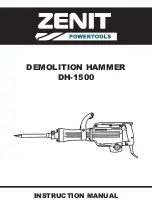
KTR-STOP
®
NC
Operating/Assembly instructions
KTR-N
Sheet:
Edition:
44545 EN
5 of 9
1
Please observe protection
note ISO 16016.
Drawn:
09.06.15 Kb/Brs
Replacing:
---
Verified:
11.06.15 Kb
Replaced by:
!
Leakages have to be removed immediately. Oil which has escaped has to be removed
completely, since oil remains may vaporize on hot components and ignite.
!
As long as there is no shaft or cylindrical piston rod in the clamping area of KTR-STOP
®
NC
it is absolutely necessary to keep the clamping/braking system open under pressure.
Please make sure that the connections and hoses are
adapted to the system with regard to pressure, flow rate,
temperature and liquidity.
Any hoses which are located close to mobile
components should be secured or coated accordingly.
Illustration 4: Pressure port
Connection 2 serves as an alternative oil connection (see
illustration 4). In order to assure its operation, a
hydraulic hose may only be connected to one out of the
two connections 1 or 2 (illustration 5).
Connect a manual hydraulic pump to one of the two oil connections (see
illustration 4). For that purpose remove the screw plug (illustration 2)
beforehand.
Vent the clamping and braking system and the hydraulic system. Use
the oil connection on top for venting.
!
Make sure that the venting holes always point upwards to ensure that the air can escape
from the system.
Illustration 5: Releasing the clamping and braking system
(unlocking)
Illustration 6: Clamping the clamping and braking system
(locking)
For locking or clamping release the pressure from the hydraulic system (see illustration 6).
!
Make sure there is a shaft in the clamping area of the system.
4
Assembly
4.2 Hydraulic connection of clamping and braking system



























